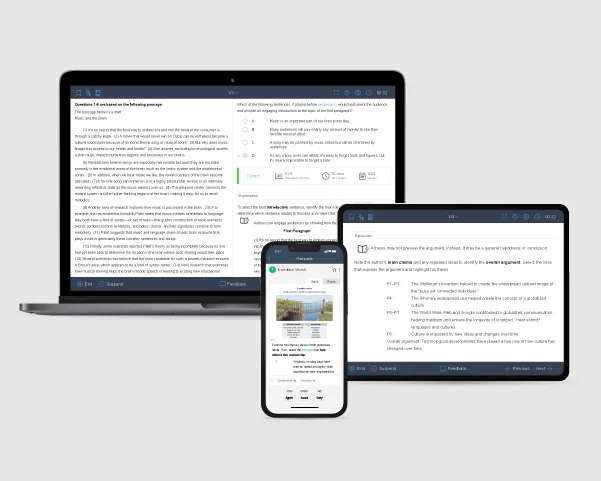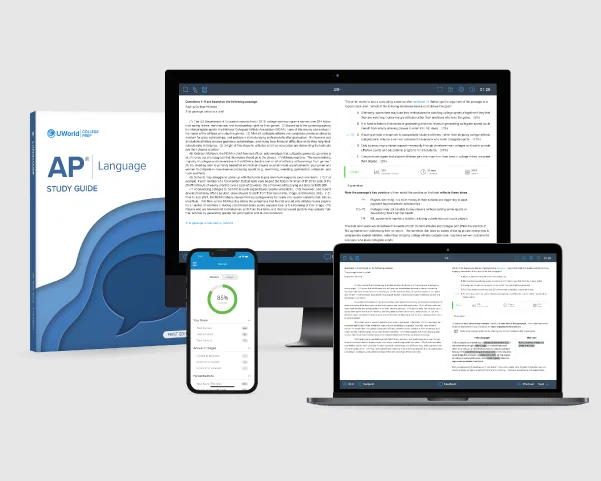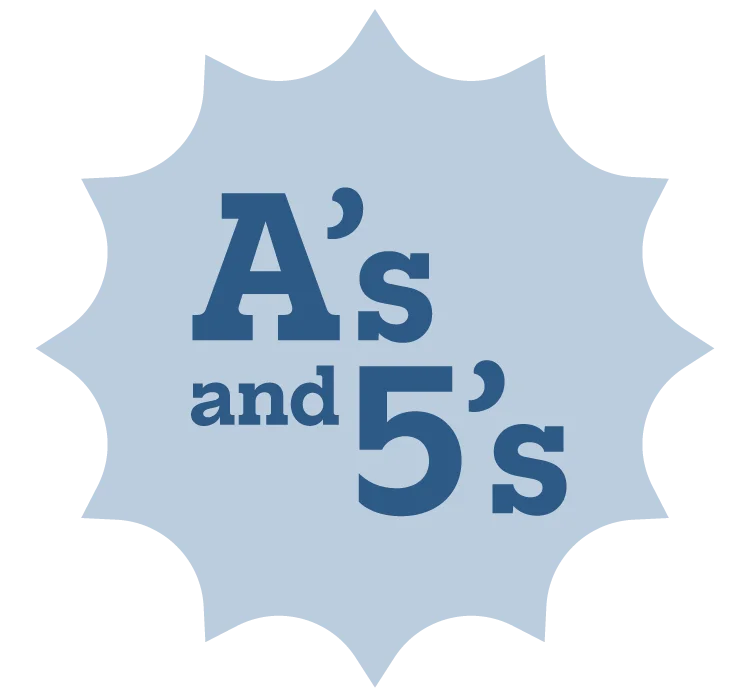What Is the Format of the AP English Language Exam?
The AP English Language and Composition exam lasts 3 hours and 15 minutes and includes two main sections — Section I: Multiple-Choice and Section II: Free-Response. The table below shows a breakdown of each section covered in the AP English Language and Composition exam format:
| Section I: Multiple-Choice Questions (MCQs) | Section II: Free-Response Questions (FRQs) |
|---|---|
|
|
Section I of the exam, the multiple-choice part, is divided into five sets. It includes 23–25 reading questions in the first two sets, where you are required to read and analyze nonfiction texts, and 20–22 writing questions in the other three sets, which require you to read like a writer and consider revisions to the text. The multiple-choice section has a one-hour time limit, accounting for 45% of your total exam score.
In Section II of the exam, the free-response section, you'll respond to three questions with written answers. This section tests your composition skills in three areas: synthesis, rhetorical analysis, and argument. This section is 2 hours and 15 minutes long, accounting for 55% of your total exam score.
Types of Questions in AP English Language and Composition Exam
As mentioned above, the AP English Language and Composition exam format includes multiple-choice and free-response questions. These questions assess your ability to perform college-level work. Following are the types of questions you’ll see on the AP Lang exam.
Multiple-choice questions (MCQs)
Section I includes AP English Language multiple-choice questions, two reading passages, and three writing passages. The two reading sets are nonfiction passages from various sources. The objective is to get you to pay attention to rhetorical devices, figures of speech, and intended purposes quickly and with new material. The three writing passages are all essays “written by students.” The aim is to get you to revise the essay in a way that helps the writer reach their goal.
In this section, you get one point for each correct answer to a question. There is no penalty for wrong answers, so answer all the questions, even if you have to guess on a few.
The exam includes five sets of the multiple-choice section given as follows, based on the skills that will be tested in each set:
| Set | No. of Questions Per Set | Skills Assessed |
|---|---|---|
| 1 | 11-14 | Reading skills (1, 3, 5, 7) |
| 2 | 11-14 | Reading skills (1, 3, 5, 7) |
| 3 | 7-9 | Writing skills (2, 4, 6, 8) |
| 4 | 7-9 | Writing skills (2, 4, 6, 8) |
| 5 | 4-6 | Writing skills (2, 4, 6, 8) |
The AP English Language curriculum covers eight sets of skills. Knowing the weight of these skills in the multiple-choice questions proves helpful. The multiple-choice section of the AP English Language and Composition test assigns the following weights to each of the eight skill categories.
| Skill Categories | Exam Weight |
|---|---|
| Rhetorical Situation: Reading | 11%–14% |
| Rhetorical Situation: Writing | 11%–14% |
| Claims and Evidence: Reading | 13%–16% |
| Claims and Evidence: Writing | 11%–14% |
| Reasoning and Organization: Reading | 13%–16% |
| Reasoning and Organization: Writing | 11%–14% |
| Style: Reading | 11%–14% |
| Style: Writing | 11%–14% |
To help you ace this section, read our article on how to approach AP English Language multiple-choice questions. There are also step-by-step instructions on answering each question on the page.
Now that you know everything about Section I, let's look at Section II.

Free-response questions (FRQs)
Free-response questions require responses in paragraph form. The AP Readers look at each student's free-response answer and give it a score based on the criteria set for each question. College Board® rubrics for each question are used to grade each essay on a scale from 0 to 6. All of the rubrics are almost the same, with only minor differences.
FRQ 1: Synthesis Question
In the first free-response question, students are given six to seven sources structured around the same topic. Two of the sources given are visual, and at least one of them provides data. The rest of the sources are short texts, each with about 500 words. Students must write an essay combining information from at least three sources and explaining their point of view on the topic. This question examines how well students can:
- Respond to the prompt with a thesis that may establish a line of reasoning.
- Provide evidence from at least three sources to support the thesis. Indicate the sources used through direct quotation, paraphrase, or summary. Cite sources as Source A, B, etc., or use the description in parentheses.
- Explain the relationship between the evidence and the thesis.
- Demonstrate an understanding of the rhetorical situation.
- Use appropriate grammar and punctuation when communicating the argument.
| Rubric Criteria | Points | |
|---|---|---|
| Row A | Responds to the prompt with a thesis that presents a defensible position. | 1 |
| Row B | Provides specific evidence and commentary consistently. | 4 |
| Row C | Demonstrates sophistication of thought and/or a complex understanding of the rhetorical situation. | 1 |
FRQ 2: Rhetorical Analysis
In the second free-response question, students are given about 600 to 800 words of nonfiction prose. Students must write an essay analyzing the writer's rhetorical choices. This question examines how well students can do the following:
- Respond to the prompt with a thesis analyzing the writer’s rhetorical choices.
- Select and use evidence to develop and support the line of reasoning.
- Explain the relationship between the evidence and the thesis.
- Demonstrate an understanding of the rhetorical situation.
- Use appropriate grammar and punctuation when communicating the argument.
| Rubric Criteria | Points | |
|---|---|---|
| Row A | Responds to the prompt with a defensible thesis that analyzes the writer’s rhetorical choices. | 1 |
| Row B | Provides specific evidence and commentary consistently, and also describes how multiple rhetorical strategies support the author's argument, intention, or message. |
4 |
| Row C | The response demonstrates sophistication of thought and/or a complex understanding of the rhetorical situation. | 1 |
FRQ 3: Argument
The third free-response question provides students with an idea or concept. Students must write an essay using evidence to support their point of view. This question examines how well students can:
- Respond to the prompt with a thesis that may establish a line of reasoning.
- Select and use evidence to develop and support the line of reasoning.
- Explain the relationship between the evidence and the thesis.
- Demonstrate an understanding of the rhetorical situation.
- Use appropriate grammar and punctuation when communicating the argument.
| Rubric Criteria | Points | |
|---|---|---|
| Row A | Responds to the prompt with a thesis that presents a defensible position | 1 |
| Row B | Provides specific evidence and commentary consistently. | 4 |
| Row C | Demonstrates sophistication of thought and/or a complex understanding of the rhetorical situation. | 1 |
To do well on this part, read the article on how to answer AP English Language and Composition free-response questions. There are also step-by-step instructions on answering each question on the page.
Is the AP English Language Exam Available in Paper or Digital Mode?
The AP English Language exam is fully digital, which means you have to take both the MCQ and FRQ sections in the Bluebook testing app.
The entire exam is designed to demonstrate students' understanding of how an author uses language, genre conventions, and rhetorical choices to generate meaning. A qualifying score demonstrates your ability to complete college-level work. Now that you understand the AP Lang exam format and what to expect from each section, you can come up with a way to study that will be both efficient and effective. You need to keep in mind how many questions are in each section and how much time you need to complete each portion. Also, don't forget to review your answers.
Looking for a premium resource to help you ace the AP Lang exam? Check out UWorld's AP English Language prep course, consisting of a study guide with comprehensive coverage of the content and a QBank with challenging questions and detailed answer explanations to make your exam prep more competitive yet easier than ever.

References
- AP English Language and Composition. (n.d.). Apcentral.collegeboard.org. Retrieved on January 10, 2025, from https://apcentral.collegeboard.org/courses/ap-english-language-and-composition
- AP English Language and Composition. (n.d.). Apcentral.collegeboard.org. Retrieved on January 10, 2025, from https://apcentral.collegeboard.org/courses/ap-english-language-and-composition/exam
- AP English Language and Composition Course and Exam Description. (Fall 2024). Apcentral.collegeboard.org. Retrieved on January 10, 2025, from https://apcentral.collegeboard.org/media/pdf/ap-english-language-and-composition-course-and-exam-description.pdf
- AP English Language and Composition Free-Response Questions Scoring Rubrics. (2024). Apcentral.collegeboard.org. Retrieved on January 10, 2025, from https://apcentral.collegeboard.org/media/pdf/ap24-sg-english-language-set-1.pdf
Read More About AP English Language Exam
Looking for a simpler AP English Language CED? Check out this guide to the AP Language coursework for detailed information on the units, key concepts, course skills, & more!
AP English Language Scoring GuideCrunch some numbers with our AP Language exam scoring guide—including score distribution information, crucial rubrics, and minimum score requirements for college credits.
AP English Language Study Plan & TipsWant to know the best ways to do well in the AP English Lang exam? Go through our AP Lang expert guide with all the strategies that will help you get a 5 on the test effortlessly.
Best AP English Language Study Guide ComparisonCompare the best AP Eng Lang study guides! See how Kaplan, Barron's, and Princeton Review stack up against UWorld for comprehensive exam prep.
Best AP English Language Prep Course ReviewSearching for top AP Eng Lang prep courses? Read this review to compare the best courses and choose the perfect one for your success.
How to Self-Study for AP English LanguageWant to ace AP English Language & Composition on your own? Follow this expert self-study guide with tips, tricks, and tools to prepare effectively for the exam.




